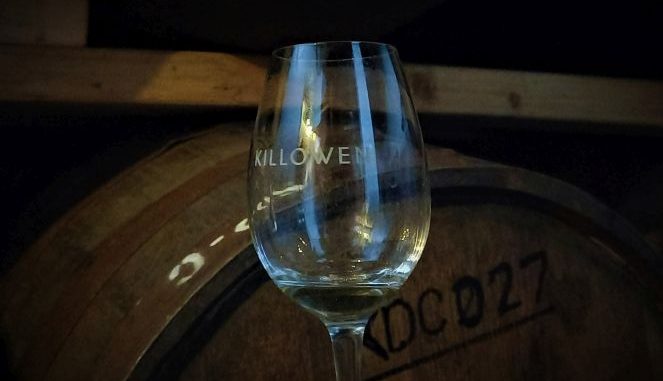
(Note from the author: This is a automated translation from the original German text)
The Killowen Distillery is located in the north-east of the Irish
island. Its modest home is on the southern slopes of the mighty
Mourne Mountains. These slope down towards Carlingford Lough, a
sea inlet that separates the mountains from the Cooley peninsula.
That’s right, Cooley. A name that has a familiar ring in the Irish
whiskey universe. Because only a few kilometres from Killowen as
the crow flies is the Cooley Distillery, from the late 80s the
nucleus of the resistance of Irish whiskey production against the
duopoly of the mass distilleries from Bushmills and Midleton. When
John Teeling, founder of the Cooley Distillery, began distilling
whiskey in 1987, Brendan Carty, founder of the Killowen
Distillery, had no idea that he would follow a similar path almost
30 years later. Only on a much smaller scale than John Teeling
once did.
Garage Days
When you enter Killowen Distillery, you are inevitably reminded of
the many success stories that exist about the Bill Gates and
Metallicas of the world. Founded in a garage, they set out to
conquer the world of computers and a music genre respectively.
Brendan’s Whiskey is created in a similar setting. Even the narrow
mountain road leading up the slopes from the bay is a little
adventure. If you miss the entrance to the distillery (which can
happen quickly if you don’t know exactly where you are going),
there is only a turnaround after a few hundred metres.
Next to and
in front of the distillery building, there is little more than a
parking space between IBCs and pallets, and it is best to
manoeuvre directly backwards onto the small site in order to get
out again unharmed later. The building itself is a renovated shed,
just big enough to house a small tractor. The year 1958 is carved
into the stone on the front gable. Behind the building is a
pasture complete with horses. Behind it, more pastures follow as
far as the eye can see.
A visit to Brendan Carty
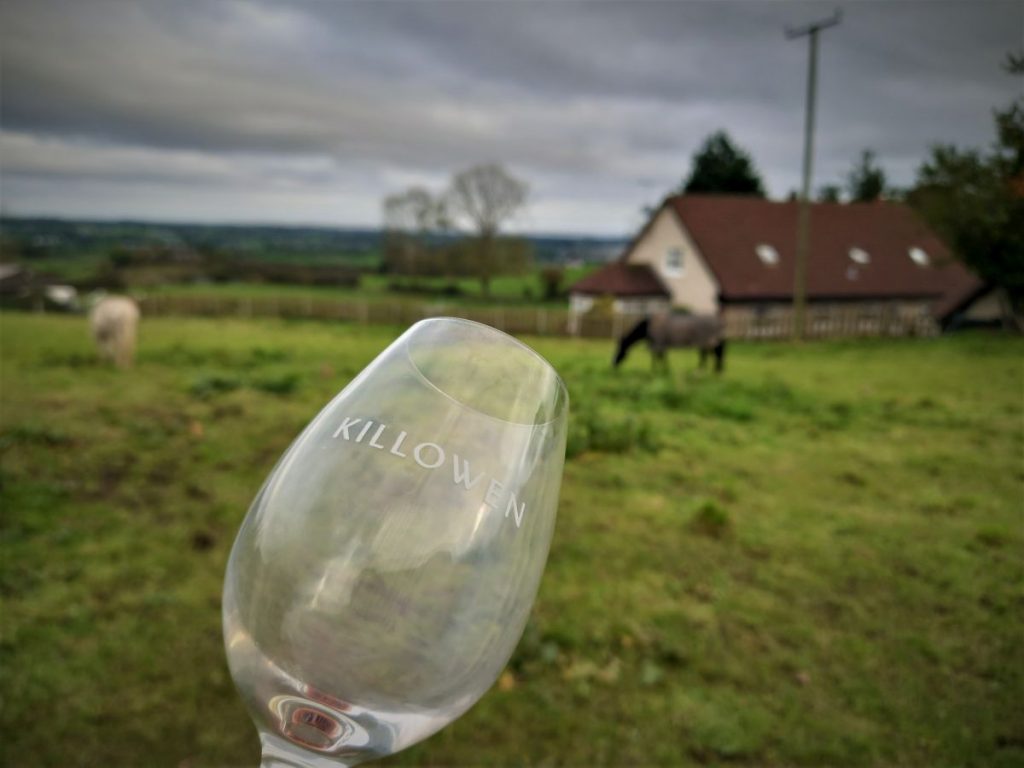
A large swinging gate opens to reveal the inner workings of the
Killowen Distillery. There to greet us is Brendan Carty, smiling
in the middle of his empire. For the first few years, his
distillery was considered the smallest in Ireland. Today, more
enthusiasts have built micro-distilleries and are vying for this
title. For Brendan, that doesn’t matter. His priority is to pursue
his passion here. For this purpose, there is a mashtun, two
washbacks and two Portuguese copper stills at the back of the
room. Their lower section is encased in bricks.
Unlike usual, the stills are directly fired. Their capacity: 1000 litres
and 500 litres.
„For our small batches, we only fill the pot stills halfway. This
allows the raw spirit to interact more with the copper,“ Brendan
explains. This already makes it clear what he is about: class
before mass. Brendan produces only 135 litres of alcohol a week
on his plant.
The Milk is in the warehouse
Brendan leads me out of the production room into a small side
room. Here there is a small counter with bar stools. Some
Killowen products are randomly arranged on a Euro pallet
converted into a shelf in the background of the bar.
Countless glasses are spread across the bar area. Gin glasses
hang from the ceiling. On the bar, Brendan’s laptop glows in
energy-saving mode. He offers me a tea, which I gratefully
accept. „Can you get the milk? It’s next door in the storeroom,“
he asks me in his strong Irish accent. I enter the storeroom.
Light falls dimly through the few windows. To the right and left,
barrels of various sizes are stored on two-storey shelves.
Brendan’s warehouse is hardly bigger than his small office bar
next door, the number of barrels stored is manageable. Small
batch. I find the milk between two barrels, take the carton and
return to Brendan. „The storeroom is cool enough for the milk,“
he grins at me. I laugh.
The architecture of a business plan
We sit down and I ask him how all this came about. Brendan begins
his story in Australia. He moved there in the 2010s after studying
architecture. Ireland was in recession after the financial crash a
few years earlier. The construction industry in particular was
suffering and there were no jobs for architects. So he went to the
other side of the globe and worked there for three years. Around
2015, he came into contact with the whiskeys of the Belgrove
Distillery. Brendan: „These young whiskeys tasted incredibly good,
better than the best Redbreast I knew.“
He began to look into the
distillery, its owner and his production methods. What he
discovered fascinated him: „Peter from Belgrove has a micro
distillery in Tasmania. His stills are fired by direct flame. And
he experiments with mixed mashbills and made them his trademark.“
Direct flame? Mixed mashbills? The similarities to Brendan’s
current concept become apparent. „In fact, at the time I began to
wonder how a small distillery like that could work in Ireland,“ he
opens.

Where Brendan Carty’s inspiration came from
But it took two more impulses to take the step from architect to
distiller. The first of these took place at the Dingle Whiskey Bar
in Dublin. While on home leave, Brendan took part in a tasting led
by Fionnán O’Connor. The latter had published his book on Irish
pot still whiskey in autumn 2015. „A discussion about pot still
whiskey started everywhere,“ Brendan recalls. Specifically about
what belongs in traditional mashbills and what current legislation
dictates.
This topic began to excite Brendan. Back in Australia,
he devoured Fionnán’s work and an inner fire for historic
mashbills began to simmer.
Making pot still whiskey himself and experimenting with mashbills
like the Belgrove Distillery suddenly seemed less and less
outlandish. But Brendan still had his doubts about whether he
could
enough of a businessman to take the step back to Ireland and
become a self-employed distiller.
When it all came together
Then he received the second, the decisive push. His childhood
friend Shane McCarty had founded an export company for beer and
spirits in the meantime and was successful with it. I asked Shane:
„Can you lend me your balls,“ Brendan laughs. Because the courage
his friend had shown was all he was still lacking himself. He had
already quietly drawn up a business plan. „It was actually more
like a book. It contained all my research,“ he looks back. After
bringing his second childhood friend Liam Brogan on board, the
Killowen Distillery adventure finally began in 2017. „I sat with
Liam over a cup of tea and afterwards we went to see Joe, the
owner of this shed. We asked him if he could hand it over and
suddenly we had our distillery site.“
The friendship with Liam and Shane goes back to the childhood
days of the three. „They are both from Hilltown, a small village
in the mountains nearby. We went to St Colman’s College in Newry
together when we were 10, 11. Shane sat next to me on the first
day of school. We’ve been friends ever since.“ During college,
the three lived together, went to the same bars in Belfast.
Today, the two are partners in Brendan’s Killowen Distillery and
also the brains behind the independent bottler Two Stacks.
Brendan Carty and Killowen Distillery: It’s all about quality
Back to the business plan: Brendan built the distillery small.
Very small. He has to do all the processes manually. Every
movement, every filling, draining, cleaning requires manual
labour. Because of the direct firing of the stills, the
temperature must always be kept in view. However, he attaches
great importance to precisely these small details: „I am convinced
that the way we produce ensures the quality of our products. With
every automation, every professionalisation, you lose a little of
the artisanal magic.“
The secret is its stills, made in Portugal.
„Nowadays, most of the stills come from Forsyths in Scotland. They
use a hard copper there. In contrast, the copper of the Portuguese
stills is much softer. There is more interaction during
distillation. The disadvantage is that they wear out more
quickly,“ Brendan explains.
Where its raw materials come from? „We live in a globalised world.
Nowadays, many things come from very different places. In our
region, mainly oats are grown and we procure them locally,“ the
distiller knows. In contrast, his barley comes from other regions
of the island, rye or wheat from the European continent.
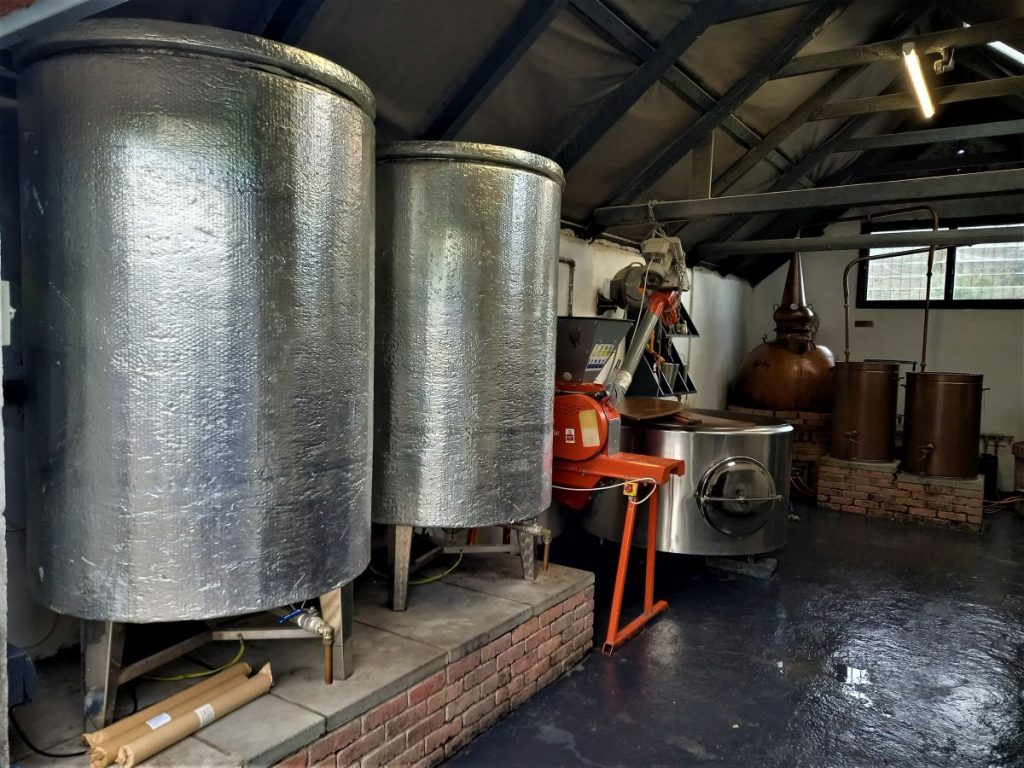
Peated, Baby!
You can
even smell some of the local production around the Killowen
Distillery. While Brendan gets his malted barley ready-made from
the large malting plants, he dries the oats himself on site. In a
small tin shed at the other end of the premises, a peat fire
smoulders behind a two-winged sliding door and smokes the oats for
his own production. Periodically, Brendan enters the small smoker
and turns the grain. „It’s not a nice job, of course. Your eyes
water, your clothes stink beastly afterwards,“ he describes the
activity. „But this is also part of the artisanal process. And we
couldn’t get smoked oats in our small quantities. So we do it
ourselves.“
What Brendan produces in his distillery is primarily poitín and
whiskey. And peaty flavours play a big part in that. „I love
peated whiskey,“ Brendan confesses. „And traditionally, poitín and
whiskey were almost always peated, because peat was the most
common and sometimes the only fuel in the country.“ He places a
lot of value on traditions like these. And on living out his love
for historic mashbills. With the Bulcán, he revived one of the
oldest known Poitín mashbills made from 50 per cent barley and 50
per cent oats in the spring of 2022. In doing so, Brendan came
full circle, as he worked with Fionnán O’Connor in researching the
old recipe.
together. The author who had inspired him so much a few years
earlier.
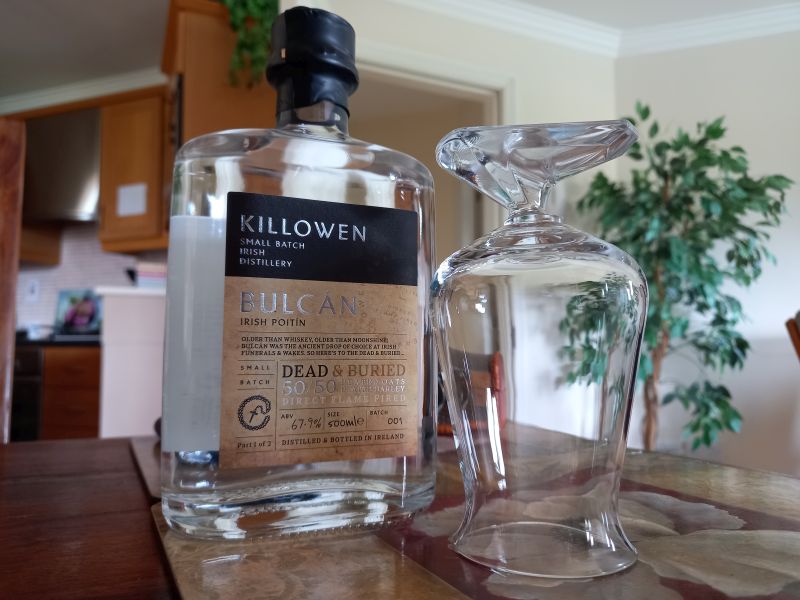
Killowen Distillery: Tradition and progress
However, Brendan and his products don’t just want to be seen as
traditional. „People say that there is glory in the past. But that
is a dangerous way of looking at things. Whether it’s for an
industry or for a society. It’s not about ‚make whiskey great
again‘,“ he philosophises with a laugh. Rather, Brendan is
concerned with other things: „I myself am more of an artist than a
technician. I’m also about expressing myself.“ Above all, it’s
about experimentation.
This is evident in his previous whiskey releases. For lack of his
own finished distillate, he sourced whiskeys from other
distilleries and gave them different finishes. His Bonded
Experimental Series earns its name. Here he experiments with the
same whiskey in different barrels. But if you expect the usual
port and sherry finishes, you are mistaken. Instead, terms like
Txakolina Acacia Cask, Virgin Hungarian Oak or Ex-Peated Islay
Cask can be found on the bottle labels.
He takes the same approach with Poitín. His standard bottling
consists of malted barley, unmalted barley, oats and wheat. This
is where the Mashbill fan first shows himself. For this, he
provides the Poitín with short finishes for a limited edition,
called The Cúige. According to current legislation, up to ten
weeks are allowed as a finish. For this period, the Poitín was
put into five casks that previously contained different beers
from breweries in the five historic provinces of Ireland.
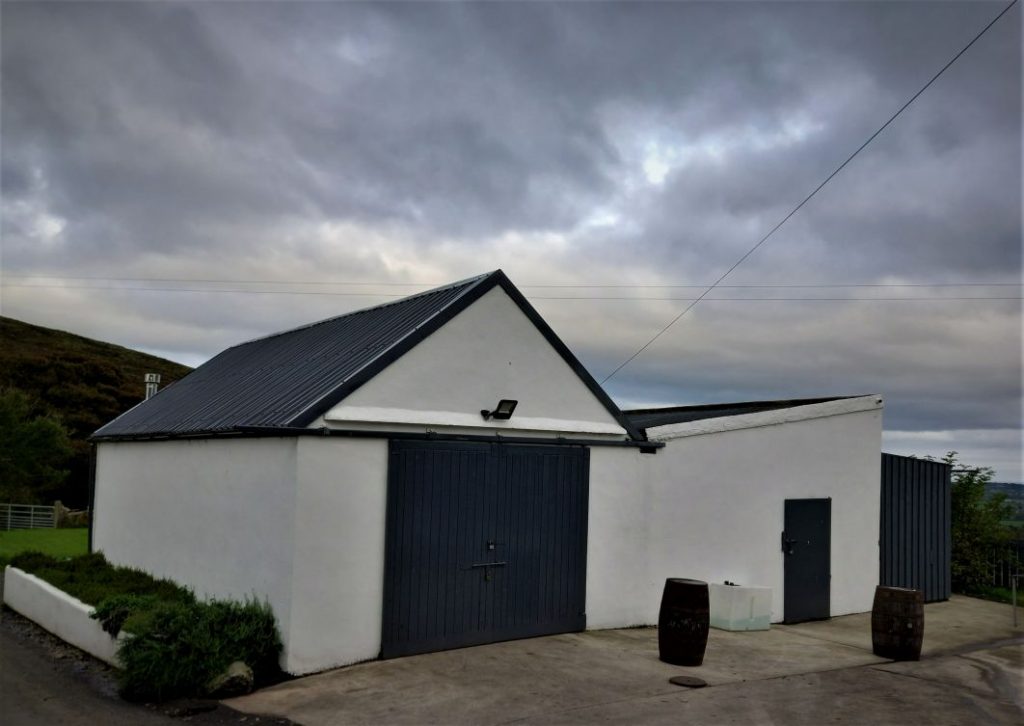
Brendan Carty and the Killowen Kult
The success of the experiments proves Brendan right. A small fan
community grew up early on. His signature whiskey release,
Killowen Rum & Raisin, is very well received batch after batch.
The individual releases from the Bonded Experimental Series are
sold out within a very short time. The same goes for The Cúige.
With such good demand, the question about the future plans of the
young distillery is not far away. Brendan returns to
experimenting: „2022 is the year of Poitín. We are working on
giving this traditionally Irish spirit more of a stage again.“ To
this end, he is launching an Experimental Poitín series, which
will highlight different components of Poitín. „I like challenges.
And sometimes you want to do crazy things,“ Brendan smiles
mysteriously. Which will be his first, own whiskey? „A pot still
whiskey,“ it shoots out of the gun.
Non-comform and non-GI
According to his own mashbill,
of course, and of course it does not conform to the current
regulations for Irish Single Pot Still Whiskey. „Then I’ll call it
something else,“ Brendan shrugs. Growth is not on his mind. „I
look at this like a hobby and I’m a firm believer that the bigger
the distillery gets, the more quality is lost.“ As he says this,
he seems almost like Peter Pan, the boy who didn’t want to grow
up. In any case, Brendan has retained the playful element and the
joy of what he does, just like the fairytale character.
At the end of April 2022, just shortly after our conversation, the
first spirit distilled by Brendan himself in Killowen became three
years old and thus officially whiskey. So the experiments in the
small distillery at the foot of the Mourne Mountains may continue.
Tralee, July 2022
